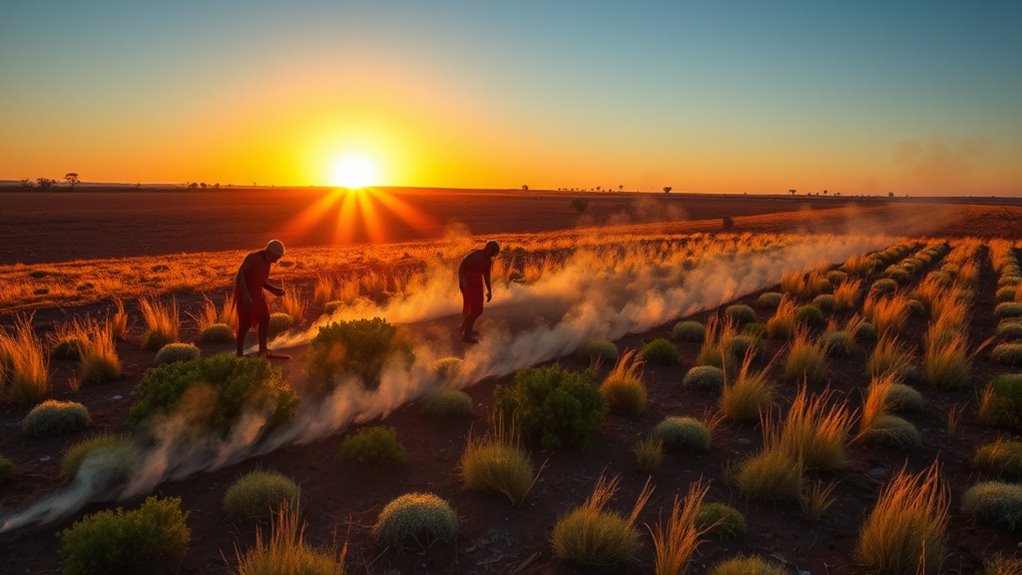Aboriginal fire-stick farming is a sophisticated practice rooted in thousands of years of traditional ecological knowledge. It uses controlled, deliberate burns during cooler seasons to shape the landscape, prevent wildfires, and promote plant growth. This method maintains ecological balance, supports food sources, and enhances hunting. Modern science recognizes these techniques as effective for land management and fire control. If you continue exploring, you’ll discover how this ancient system offers sustainable, scientifically supported solutions for ecosystem health.
Key Takeaways
- Aboriginal fire-stick farming involves deliberate, controlled burns that reduce fuel loads, preventing large wildfires and promoting ecosystem health.
- Timing burns during cooler, wetter seasons optimizes safety and ecological benefits, supporting plant growth and food sources.
- This traditional practice enhances biodiversity by maintaining habitat diversity and encouraging native plant and animal populations.
- Scientific research confirms that Aboriginal fire management improves land resilience, aids in bushfire prevention, and supports sustainable land use.
- Integrating TEK with modern science reveals the effectiveness of Aboriginal fire practices in promoting ecological balance and long-term sustainability.

Have you ever wondered how Indigenous Australians have managed their land for thousands of years? They’ve developed a deep understanding of their environment, rooted in traditional ecological knowledge that has been passed down through generations. This knowledge isn’t just about observing nature; it’s about actively shaping and maintaining the landscape to support their way of life. One of the most fascinating aspects of this land management is their fire management techniques, which are both sophisticated and sustainable.
Instead of letting wildfires rage uncontrollably, Aboriginal communities use controlled fires, often called fire-stick farming. These deliberate burns are carefully planned and executed to clear out old growth, reduce fuel loads, and encourage new plant growth. By doing this, they prevent larger, destructive fires and promote a landscape that’s rich in biodiversity. This method demonstrates a profound understanding of how fire can be a beneficial tool rather than a threat. It’s a prime example of traditional ecological knowledge that recognizes fire as a natural and necessary part of the ecosystem.
Aboriginal fire-stick farming uses controlled burns to promote biodiversity and prevent destructive wildfires.
Your ancestors knew that timing and technique matter. They would burn during specific seasons, usually when the weather was cooler and wetter, to minimize the risk of the fire spreading uncontrollably. They also chose particular areas for burning, often based on the type of vegetation or the presence of animals they depended on. These fire management techniques helped sustain food sources, create pathways, and even improve visibility for hunting. The fires also stimulated the growth of certain plants, such as bush tomatoes and native grasses, which thrived after a burn.
What’s truly remarkable is how this knowledge integrates ecological understanding with cultural practices. Every burn was a calculated move, part of a broader strategy to maintain balance in the environment. These methods proved their effectiveness over thousands of years, allowing Indigenous Australians to live in harmony with their land. Modern science is now catching up, recognizing that their traditional fire management techniques can help address contemporary issues like bushfire control and land restoration. Recognizing these practices as traditional ecological knowledge underscores their significance and potential for modern application.
Frequently Asked Questions
How Do Fire-Stick Farming Techniques Vary Among Different Aboriginal Groups?
You’ll find that fire-stick farming techniques vary among different Aboriginal groups due to cultural variations and regional adaptations. Each community customizes their burning practices based on local environment, plant species, and traditional knowledge. Some use controlled burns to promote specific flora, while others focus on hunting or safety. These differences highlight how diverse cultural practices and regional landscapes shape fire management, ensuring sustainable use of land for generations.
What Long-Term Ecological Impacts Does Fire-Stick Farming Have on Australian Landscapes?
You might wonder about fire-stick farming’s long-term effects on Australian landscapes. It enhances soil health by promoting nutrient recycling and reduces invasive plant species. This practice increases plant diversity by encouraging a variety of native species to thrive. Over time, fire-stick farming helps maintain balanced ecosystems, prevents large wildfires, and supports sustainable land management. Your involvement in understanding these impacts highlights its critical role in preserving Australia’s unique, resilient environment.
How Has Modern Science Validated Traditional Aboriginal Fire Management Practices?
You might be surprised to learn that modern science validates Aboriginal fire management practices by recognizing their cultural significance and ecological resilience. Researchers find that controlled burns help prevent larger wildfires, maintain biodiversity, and support healthy ecosystems. By respecting traditional knowledge, science confirms that fire-stick farming isn’t just cultural, but a essential, sustainable tool for ecological balance. This validation highlights the deep connection between Indigenous practices and environmental health.
Are There Risks Associated With Reintroducing Fire-Stick Farming Today?
Reintroducing fire-stick farming today involves risks like unintended wildfires, which could threaten land and safety. However, it also promotes cultural preservation and affirms land rights, helping communities reconnect with traditional practices. To minimize risks, you need proper planning and expert guidance. Balancing safety with cultural and environmental benefits ensures that fire management supports land stewardship and respects Aboriginal heritage, fostering a sustainable future.
How Do Aboriginal Fire Practices Influence Biodiversity Conservation Efforts?
You might not realize it, but Aboriginal fire practices substantially boost biodiversity, with some areas showing a 30% increase in plant and animal diversity. These practices hold deep cultural significance, preserving traditions and land stewardship. By carefully managing fire, you help maintain ecological balance, reducing large-scale wildfires and supporting healthy ecosystems. Embracing these ancient methods can strengthen conservation efforts, ensuring both cultural heritage and biodiversity thrive for generations to come.
Conclusion
As you now see, Aboriginal fire-stick farming isn’t just about burning; it’s a sophisticated land management technique. Did you know that some areas, thanks to these practices, have remained resilient for thousands of years? This ancient method helped maintain biodiversity and prevent larger wildfires, proving its lasting impact. So next time you hear about eco-friendly land care, remember how Aboriginal fire-sticks shaped ecosystems—showing us that sometimes, the oldest methods are the most effective.









